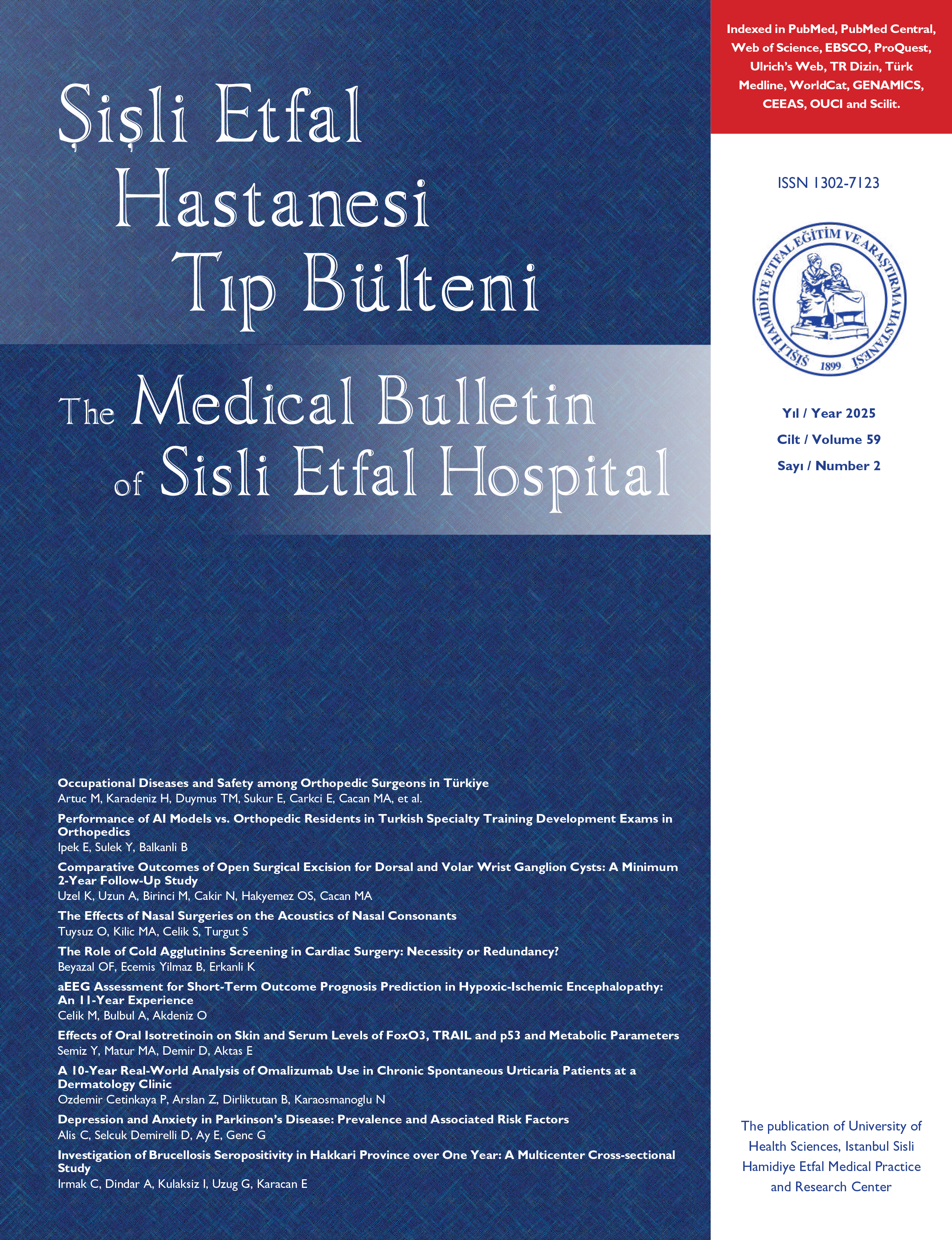
Comparison of nasal airway splint, synthetic polyurethane foam (nasopore) and transseptal suture technique in septoplasty
Gülpembe Bozkurt1, Eymen Oruç2, Arzu Yasemin Korkut1, Berna Uslu Coşkun11Şişli Hamidiye Etfal Eğitim ve Araştırma Hastanesi, Kulak Burun Boğaz Kliniği, İstanbul - Türkiye2Araklı Devlet Hastanesi, Trabzon - Türkiye
Objective: A prospective randomised study for comparison of the efficacy and possible complications of nasal airway splint, synthetic polyurethane foam (nasopore) and transseptal suture technique in septoplasty.
Material and Methods: 60 patients underwent septoplasty for septal deviation. These patients were divided into three groups: nasal airway splint (using intranasal septal splints at the end of the operation) (Group I), nasopore (using nasopore packing at the end of the operation) (Group II) and non-packing (using separate trans-septum through and through horizontal mattress sutures without any mesh or intranasal splint insertion) (Group III). Patients were asked to record pain levels using a visual analogue scale. The three groups were compared for postoperative subjective complaints (pain, pressure sensation, nasal congestion, anterior rhinorrhea, postnasal drip, dysphagia, sleep disorder) and complications (perforation, hematoma, infection, synechiae, postoperative bleeding).
Results: There were no significant statistical differences between the three groups with respect to the complication parameters studied, but higher postnasal drip levels in Group II compared to the Group I and also no statistical differences in the other parameters (pain, nasal congestion, anterior rhinorrhea, dysphagia, sleep disorder) were found.
Conclusion: Our results suggest that nasopore insertion did not benefit more than those who had trans-septum through and through suturing and intranazal splint. Moreover, internal nazal splint and tansseptal suture technique is much preferable because of the higher cost of nasopore.
Septoplastide transseptal sütür, nazopor ve splint kullanımının karşılaştırılması
Gülpembe Bozkurt1, Eymen Oruç2, Arzu Yasemin Korkut1, Berna Uslu Coşkun11Şişli Hamidiye Etfal Eğitim ve Araştırma Hastanesi, Kulak Burun Boğaz Kliniği, İstanbul - Türkiye2Araklı Devlet Hastanesi, Trabzon - Türkiye
Amaç: Septoplasti sonrası havayollu internal nazal splint, sentetik poliüretan tampon (nazopor) ve transseptal sütür tekniğinin hasta yakınmaları ve konforu üzerine etkilerini ve oluşabilecek komplikasyonları karşılaştırmak amacıyla yapılan prospektif randomize çalışma.
Gereç ve Yöntemler: Septoplasti operasyonu uygulanan 60 hasta randomize bir şekilde 20şer hastadan oluşan 3 gruba ayrıldı. Postoperatif olarak Grup Idekilere havayollu internal nazal splint, Grup IIdekilere sentetik poliüretan tampon yerleştirildi ve Grup IIItekilere transseptal sütür atıldı. Görsel Analog Skorlama (GAS) ile postoperatif subjektif şikayetler (ağrı, basınç hissi, burun tıkanıklığı, anterior rinore, postnazal akıntı, disfaji, uyku bozukluğu) ve muayene ile sineşi, kanama, septal enfeksiyon, hematom, perforasyon mevcudiyeti değerlendirildi.
Bulgular: Grup IIde postnazal akıntı yakınması, Grup Iden anlamlı (p<0.05) olarak yüksek bulundu. Grup IIIte ise postnazal akıntı yakınması Grup I ve Grup IIden anlamlı (p>0.05) farklılık göstermedi. Grup IIde basınç yakınması Grup IIIten anlamlı (p<0.05) olarak yüksek bulundu. Grup Ide ise basınç yakınması Grup II ve Grup IIIten anlamlı (p>0.05) farklılık göstermedi. Hastaların ağrı, burun tıkanıklığı, anterior rinore, disfaji, uyku bozukluğu yakınmaları anlamlı (p>0.05) farklılık göstermedi. Postoperatif komplikasyonlar açısından üç grupta da istatistikselolarak anlamlı farklılık görülmedi (p>0.05).
Sonuç: Sentetik poliüretan tampon, internal nazal splint ve transseptal sütür yöntemi ile karşılaştırıldığında hasta konforunu arttırmadığı, postoperatif komplikasyonlar açısından anlamlı bir farklılık oluşturmadığı ve daha yüksek maliyetli olduğu için, daha düşük maliyetli olan internal nazal splint ve transseptal sütür yöntemi tercih edilebilir.
Manuscript Language: Turkish



















